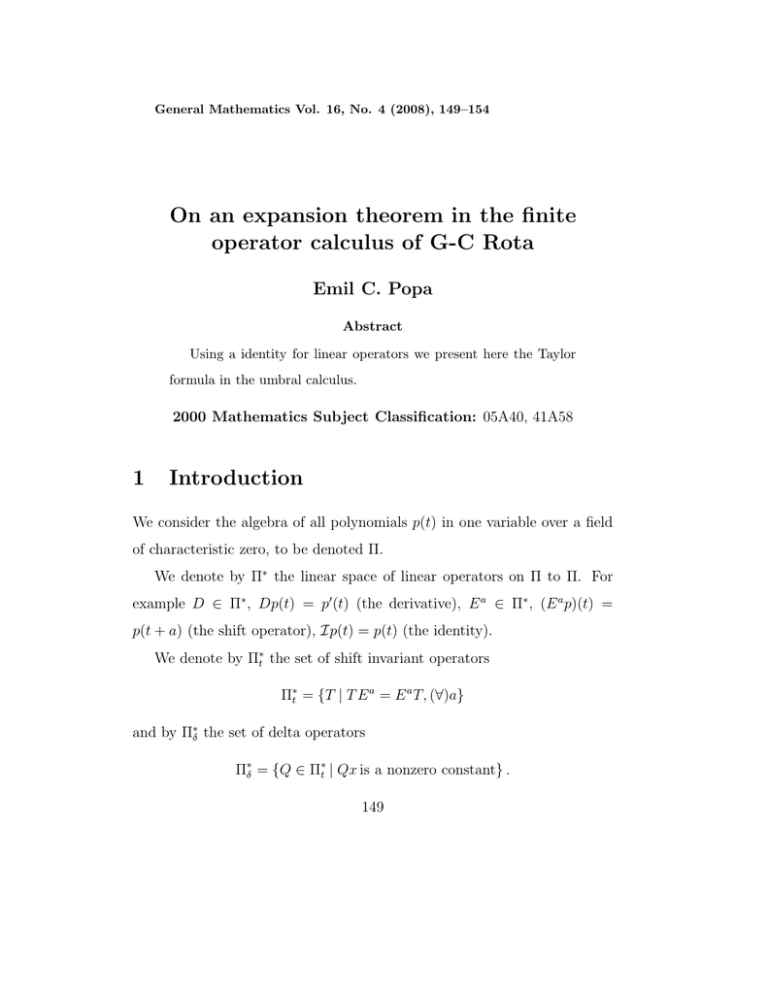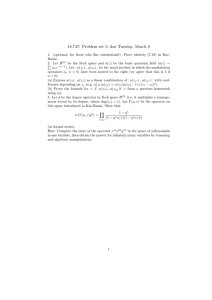On an expansion theorem in the finite 1 Introduction
advertisement

General Mathematics Vol. 16, No. 4 (2008), 149–154
On an expansion theorem in the finite
operator calculus of G-C Rota
Emil C. Popa
Abstract
Using a identity for linear operators we present here the Taylor
formula in the umbral calculus.
2000 Mathematics Subject Classification: 05A40, 41A58
1
Introduction
We consider the algebra of all polynomials p(t) in one variable over a field
of characteristic zero, to be denoted Π.
We denote by Π∗ the linear space of linear operators on Π to Π. For
example D ∈ Π∗ , Dp(t) = p (t) (the derivative), E a ∈ Π∗ , (E a p)(t) =
p(t + a) (the shift operator), Ip(t) = p(t) (the identity).
We denote by Π∗t the set of shift invariant operators
Π∗t = {T | T E a = E a T, (∀)a}
and by Π∗δ the set of delta operators
Π∗δ = {Q ∈ Π∗t | Qx is a nonzero constant} .
149
On an expansion theorem in the finite operator ...
150
Delta operators possess many of the properties of the derivative operator
D. For example if Q is a delta operator, then Qa = 0 for every constant
a. Next, if p(t) is a polynomial of degree n and Q ∈ Π∗δ , then Qp(t) is a
polynomial of degree n − 1.
A polynomial sequence (pn (t)) (deg pn = n, n = 0, 1, 2, . . . ) is called the
sequence of basic polynomials for Q ∈ Π∗δ if p0 (t) = 1, pn (0) = 0 for n ≥ 1
and Qpn (t) = npn−1 (t) for n ≥ 1.
It is known the following theorem
Theorem 1. i) Every delta operator has a unique sequence of basic polynomials.
ii) If (pn (t)) is a basic sequence for some delta operator Q then it is a
sequence of polynomials of binomial type.
iii) If (pn (t)) is a sequence of polynomials of binomial type, then it is a
basic sequence for some delta operator.
The following theorem generalizes the Taylor expansion theorem to delta
operators and their basic polynomials.
Theorem 2. For T ∈ Π∗t and Q ∈ Π∗δ with basic set (pn ), we have
(T pk ) (0)
Qk .
(1)
T =
k!
k≥0
We consider now a operator X/
∈ Π∗t , defined by Xp(t) = tp(t) and for
any operator T defined on Π, the operator
T = T X − XT
will be called the Pincherle derivative of the operator T .
We observe that D = I, (E a ) = aE a , I = O (the null operator).
On an expansion theorem in the finite operator ...
2
The Bernoulli identity
Let T , S be two linear operators such that
T S − ST = I.
(2)
For example DX − XD = I. From (2) we obtain
T S 2 = S 2 T + 2S
and by induction
T S n = S n T + nS n−1 , n ≥ 1.
(3)
Starting with the identity
n
(4)
(αk − αk+1 ) = α0 − αn+1
k=0
for
(5)
α0 = 0, αk =
(−1)k k−1 k
S T , k≥1
(k − 1)!
and using (3) we get
αk − αk+1 =
(−1)k
T SkT k
k!
and hence
(6)
T
n
(−1)k
k=0
k!
SkT k =
(−1)n n n+1
S T
.
n!
This is the Bernoulli identity obtained by O.V. Viskov (see [1], [3]).
151
On an expansion theorem in the finite operator ...
3
152
The main result
Let Q be a delta operator with the basic set (pn (t)). Hence p0 (x) = 1,
pn (0) = 0 for n ≥ 1 and Qpn = npn−1 for n ≥ 1.
Definition 1. We define the Q-integral operator as a linear operator
7
IQ = Q dt by
1
pn+1 (t),
(IQ pn ) (t) = Q pn (t)dt =
n+1
for n ≥ 0. We denote
(7)
x
Q (Qp)(t)dt
α
= p(x) − p(α).
Definition 2. We define next the pseudo Q-integral operator
TQ ∈ Π∗ , (TQ pn )(t) = pn+1 (t).
Remark 1.For Q = D we have pn (t) = tn , n = 0, 1, 2, . . . and TQ = TD =
X, (Xp)(t) = tp(t).
Theorem 3. We have the following Taylor expansion formula
'
n &
(xI − TQ )k Qk f (x)
(8)
=
k!
k=0
'
x
n &
(xI − TQ )k Qk f (α)
((xI − TQ )n Qn+1 f ) (t)
+ Q
dt
k!
n!
α
k=0
with the rest term in the Cauchy form.
Proof. Let T, S be as below
T = Q, S = TQ − xI.
On an expansion theorem in the finite operator ...
153
We have (T S − ST )pn (t) = pn (t) and hence T S − ST = I. After submition
into (6) we get
Q
n
(−1)k
k!
k=0
Apply
(TQ − xI)k Qk p(t) =
(−1)n
(TQ − xI)n Qn+1 p(t), p(t) ∈ Π.
n!
x
Q dt
α
to both sides where, of course, t is the variable, and using (7)
to obtain
(9)
'
'
n &
n &
(xI − TQ )k Qk p (x) (xI − TQ )k Qk p (α)
=
+ Rn+1 (x)
k!
k!
k=0
k=0
where the rest term Rn+1 is in the Cauchy form
x
((xI − TQ )n Qn+1 p) (t)
dt.
(10)
Rn+1 (x) = Q
n!
α
Remark 2.For Q = D we observe that TD = X and hence
(TD p)(t) = tp(t).
Next ((xI − TD ) p) (x) = (xp(t) − tp(t))|t=x = 0 and of (9) we obtain
(11)
p(x) =
with Rn+1 (x) =
n
(x − α)k
k=0
x
α
k!
p(k) (α) + Rn+1 (x)
(x − t)n (n+1)
p
(t)dt.
n!
Remark 3.We have DX − XD = I and for T = D and S = X in the
Bernoulli identity we obtain
D
n
(−1)k
k=0
k!
X k Dk =
(−1)n n n+1
X D
n!
and finally a McLaurin expansion formula in the following form
α
n
(−α)k (k)
(−t)n+1 (n+1)
(12)
p(0) =
p (α) +
p
(t)dt.
k!
n!
0
k=0
On an expansion theorem in the finite operator ...
154
References
[1] A. K. Kwasniewski, More on the Bernouli-Taylor formula for extended
umbral clculus, Advances in Appl. Clifford Algebras, 16 (2006), 29-39.
[2] G-C. Rota, D. Kahaner, A. Odlyzko, Finite operator calculus, J. Math.
Analysis and Appl., Vol. 42 (3), June, 1973.
[3] O.V. Viskov, Noncommutative approach to classical problems of analysis,
Trudy Matematiceskovo Instituta AN SSSR, 177 (1986)(in russian).
Emil C. Popa
”Lucian Blaga” University
Department of Mathematics
Sibiu, Romania
e-mail: ecpopa2002@yahoo.com






